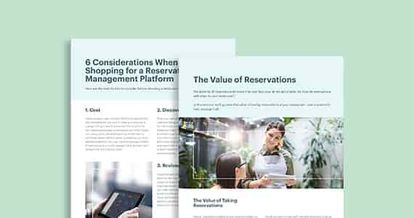Before you open a coffee shop, you will need to have a coffee shop business plan. This important document acts as a roadmap for your coffee shop business adventure – with everything you need to turn your business dreams into a reality.
If you’re passionate about coffee but have never written a business plan before, it can be nerve-racking to start. To help you out, we’ve put together a complete guide to writing a successful coffee shop business plan. In this guide, we’ll cover:
- What is a coffee shop business plan?
- How to write a business plan for a coffee shop
- The 10 sections of every successful coffee shop business plan
- A free coffee shop business plan template

Create a custom business plan for your coffee shop concept with this free template.
What is a Coffee Shop Business Plan?
A coffee shop business plan is a document that explains what your business idea is and how it will succeed. It answers several questions, like how you will set up your coffee shop, how you will fund your business, and what revenue you expect to make. It includes information about your marketing plan, sales strategy, coffee shop customers, pricing structure, competitors, required labor, and financial plan.
Similar in length to a traditional restaurant business plan, it’s a succinct document that usually spans 15-20 pages, but no more than 30 pages. Coffee shop business owners can make their plans pop with visuals like photos and designs of their coffee house, and site plans of their retail store. Charts and graphs are also used to show financial inventory information, like how much coffee beans will be purchased monthly and at what cost, for example.
Once complete, you will be able to show your coffee house business plan to potential investors, bankers, and business partners. That’s why it’s so important to dedicate a large amount of time and energy into getting your java shop business plan underway early on.

How to Write a Business Plan for a Coffee Shop
With the proper guidance, your brew shop business plan can be easy to write. That’s why having a coffee shop business plan template is a useful aid for conceptualizing your business and goals before you start to write. Additionally, having a coffee shop business plan example can help you think of key elements to demonstrate your coffee shop’s potential for growth and profitability – which are both important to attract funding.

Create a custom business plan for your coffee shop concept with this free template.
Elements of a Coffee Shop Business Plan
Executive Summary for a Coffee Business
Start with your executive summary – a short and high-level overview of each section in your coffee house business plan. In any business plan sample for a coffee shop, you’ll see that this is the first section because it gives readers crucial information about your business before you dive into details.
The executive summary section describes your business concept, the problem it solves, your target market, financial highlights, lease information, as well as your vision for the menu, products, and how you will service coffee – whether that’s in a kiosk, drive through, pickup, or sit-down coffee shop.
As you write your executive summary, consider who will read your brew shop business plan and what you would like them to know. After all, you want to capture your reader’s attention and entice them to continue to read or even invest!
Here are a few key points of interest you can mention in your executive summary:
- Ambiance: The character and atmosphere of your coffee shop
- Location: Information on your potential foot traffic, facility/lease, and seating capacity.
- Kitchen storage: Space for multiple blends of coffee or a high-end espresso machine.
- Goals: Your mission statement and guiding principles that will drive your success.
- Funding: What funds you need and how you will use them to achieve your vision.
Business Overview
The Business Overview section takes a deeper dive into the coffee industry as a whole, your local market, and what makes your coffee shop model unique among the competition. Here, start by giving a brief overview as to when and why you started your coffee shop business. In addition, you can include major achievements such as hitting target sales goals or opening new coffee shop locations.
In this section, you can also go into more detail about the business operations of your neighborhood coffee shop. For example, explain what coffee and food products you will offer, your hiring and labor practices, and how you’ll brew coffee. This, of course, will depend on your coffee shop business model.
Here are a few types of coffee shops and how they could be described:
- Grab-and-go coffee shop: Pickup or drive through only, so folks can grab a cup of coffee in a heartbeat
- Traditional coffee shop: Sells baked goodies and a variety of coffee drinks in a relaxed atmosphere
- The coffee bar: Like a homey living room, with lounge music, WiFi, and fresh coffee
Management and Staff
In this section, you will talk about ownership. Start with the business owner(s) who will manage your coffee shop, and talk about their experiences/qualifications that will make them successful. You’ll also include details of who will take care of your day-to-day coffee shop operations.
Every coffee shop will need baristas who take care of sales and make drinks, but those that sell food may also need someone to operate basic kitchen equipment. Additionally, you may want to hire someone to do marketing and advertising, or an accountant to take care of your bookkeeping.
After deciding on what jobs you want to create, you’ll need to identify if they are part-time or full-time, how you will recruit/train them (e.g., barista training), and what you will pay them in wages and benefits. Your employees will factor into your financial forecast and expenses later on in your business plan for a coffee shop, so it’s essential to get a head start on your hiring budget.

Create a custom business plan for your coffee shop concept with this free template.
Coffee Shop Market Analysis
Your Market Analysis section should show that you’ve looked at your target market, assessed your location, and understand how you’ll compete against other coffee shops in the area. Remember to consider what makes your restaurant unique and what will help it stand out. Here are two ways you can do just that:
Location
Mention if your coffee shop is in a central location, such as near a college where students break for lunch, or next to office buildings where professionals drop in on their way to work. If you are one of many coffee shops in an area, consider pointing out what makes you different, like your wide variety of specialty coffees and the quality of your food.
Customer Analysis
Include information about your ideal customer – with details on who they are, why they shop at your coffee shop, and any metrics. If you performed market research before starting your coffee shop, include that too. For example, if you have data on a high demand for espresso in your area, the sales potential for a drive-through espresso stand could be very promising.
Sample Menu
A section with a sample menu lets investors know exactly what you’ll be serving. Keep in mind that your sample menu should be a differentiator – otherwise, why would investors think that customers should choose your coffee over competitors who serve similar drinks?
Here are a few tips for choosing what to include in your great sample menu:
- Think about the types of coffee beans that could set you apart. Maybe you only serve organic coffee beans, unlike your competitors.
- Cater the types of drinks you serve to your target market. For a young customer, sweet frappuccinos, hot chocolates, and drinks topped with whipped cream can be popular. For health-conscious consumers, options like tea and “light” coffee may perform better.
- If your customers will be hungry, such as students on a lunch break, or employees on their way to work, then consider including food items like pastries.
Marketing Plan and Publicity
An effective marketing plan is essential for bringing new customers through your coffee shop’s door and retaining your loyal guests. In this section, start by describing how you want to drive incoming traffic, in addition to what budget you have in mind, and your expected return on investment. If you have a lot of detailed information, you may want to create a separate marketing plan document.
To cover all your bases, you can include the Four Ps of Marketing:
- Product: What beverage and food products you will offer? For example, will you offer non-coffee drinks, frappuccinos, espresso, or cold brews?
- Price: What is your average price point and how does it compare to competitive coffee shops?
- Place: The location of your coffee shop and how it will impact your success. For example, will you operate kiosks, and if so, where will they be placed to get the most foot traffic?
- Promos: How will you drive customers to your location(s)? Examples include live music, giving free samples, advertising, or partnering with influencers or other organizations.

Create a custom business plan for your coffee shop concept with this free template.
Business Operations and Operating Plan
The business plan operations section includes the physical requirements of your coffee shop business, like retail space, specialized equipment, supplies, and labor. When describing your business’ operational expenses, also consider showing where your coffee shop is trying to save money. For example, if you are buying used furniture or equipment, let your reader or potential investor know how you are cutting losses.
Here are a few areas you can include in the operating plan section:
Retail Space
- Space you plan to lease, buy, or rent for your coffee shop
- Parking spaces for a truck or for customers to access your coffee shop
Specialized Equipment
- Coffee machines like a coffee grinder, a brewing machine, or a hot water dispenser
- Specific arrangements like a sandwich prep table, counter space, or a display case
- Technology such as a coffee shop POS to process transactions and track inventory
Supplies
- List your suppliers according to type – for your coffee beans and other food and drink products
- Menu items you will buy vs. make in your coffee shop, such as croissants or cookies
- The frequency at which you need to restock your coffee shop inventory
Labor
- Staff such as a Barista to brew coffee
- Staff to do food preparation, menu creation, and cleaning
- A manager to oversee payroll and human resources
Financial Forecast and Expenses
This is an important section, especially if you need to attract investors to your coffee shop. Since coffee shops are often smaller storefronts, usually with a lower profit margin, this section needs to emphasize how your coffee shop business will grow and be profitable in the long-term.
Your financial forecast and expenses section should include the following:
- Cash flow statement with monthly projections for all your coffee shop purchases
- Balance sheet to give investors a snapshot of your assets, liabilities and equity
- Break even analysis to demonstrate the sales you need in order to make a profit
Coffee Shop Business Plan: Next Steps and Plan Template
To get ideas of details to include, use a coffee shop business plan sample.
Whether you own a coffee shop or are just starting out, writing a coffee shop business plan is essential to your success. In such a highly competitive coffee market, you need a business plan to show potential investors what makes your store stand out.
If you’re looking for a coffee shop business plan example, a template is a great place to start. By using a coffee business plan template, you can improve your chances of securing funding or attracting new business partners. Using a business plan sample for a coffee shop will also keep you organized and show readers how your coffee shop can be successful.
FAQs: Coffee Shop Business Plan
If you have any lingering questions, we’ve answered the top coffee shop business plan FAQs.
How profitable is a coffee shop?
A coffee shop business’ profits can range from 2.5% to 85% of gross sales, according to this Chron article. The amount of profit depends on the size of your coffee shop – smaller coffee shops usually have lower profits.
How do you start a coffee shop business?
To start a coffee shop business, do lots of research on the industry and your market so you can plan how to separate yourself, your menu, and the quality of your products from competitor coffee shops. Consider where your coffee shop might be located and what kind of customer base you’ll have. Map out the expected costs for operations, marketing, etc. in a financial plan. This will help you plan a strategy for success so you can create a strong coffee shop business plan to present to potential investors.
How much budget is needed to open a coffee shop?
How much budget you need to open a coffee shop will depend on the location of your business. Start by doing some research on real estate in the area where you want your coffee shop business, suppliers for your menu items, cost of hiring employees, and other operating costs. Also, consider what kind of marketing campaigns – such as email, direct mail, and advertisements – that you might want to run and include those in your budget too.
How do you start a business proposal for a coffee shop?
To start a business proposal for a coffee shop, use a coffee shop business plan sample and make sure you include the key sections: an executive summary, business overview, management and staff, market analysis, marketing and publicity, operations plan, and financial forecast and expenses.
Also, make sure you do enough research before you start so you understand how a coffee shop business works, your market, and your competitors, and have relevant facts and figures to support the plan for your new business.

Create a custom business plan for your coffee shop concept with this free template.
Download our free inventory template
Sign up for our free weekly TouchBistro Newsletter







